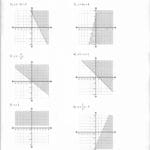This comprehensive guide provides everything you need to master compound inequalities, from free printable worksheets and engaging video tutorials to step-by-step explanations and targeted practice exercises. Whether you’re a student preparing for exams or simply looking to strengthen your algebra skills, this resource has you covered.
Understanding Compound Inequalities
Compound inequalities combine two or more simple inequalities using “and” or “or.” Let’s explore these connectors:
“And” (Conjunction): Requires both inequalities to be true simultaneously. The solution set is the intersection or overlap of the individual solutions. Think of it like finding common interests between two friends – only what they both like makes the cut. On a number line, this appears as a single, continuous segment.
“Or” (Disjunction): Requires at least one inequality to be true. The solution set is the union or combination of the individual solutions. It’s more inclusive, like a combined guest list from two friend groups. On a number line, this can look like two separate segments, although sometimes they might overlap or even merge into one.
Solving Compound Inequalities: A Step-by-Step Approach
Isolate: Treat each inequality separately. Solve each as if it were a simple inequality, isolating the variable (like ‘x’).
Combine (Or): For “or” inequalities, merge the solution sets. The final solution includes any value that satisfies either (or both) of the original inequalities.
Find the Overlap (And): For “and” inequalities, identify the values that satisfy both inequalities. This is the overlapping region of the individual solutions.
Types of Compound Inequalities
Conjunctions (“And”): Often expressed as a < x < b (e.g., 2 < x < 5), meaning x is greater than ‘a’ and less than ‘b’.
Disjunctions (“Or”): Often expressed as x < a or x > b (e.g., x < 1 or x > 3), meaning x is either less than ‘a’ or greater than ‘b’.
Absolute Value Inequalities: These can often be rewritten as compound inequalities, using either “and” or “or.” Some researchers suggest that recognizing this relationship makes absolute value inequalities less daunting.
Free Printable Worksheets: Practice Makes Perfect
Boost your skills with free printable compound inequality worksheets. These resources offer various difficulty levels and problem types, including “and/or” inequalities, absolute value problems, and graphing exercises. Here are some recommended sources:
| Website | Description | Suitable For |
|---|---|---|
| Math Worksheets 4 Kids | Excellent starting point for beginners. Focuses on solving and choosing solutions. | Beginners |
| Kuta Software | Customizable worksheets (including graphing). Offers a free trial for Infinite Algebra 1. | Various levels |
| PrintableWorksheets.in | Offers a selection of printable worksheets covering various aspects of compound inequalities. | Various levels |
| Math-Aids.com | Create custom worksheets, selecting the type of inequality (graphing in particular). | Various levels |
| MathMonks.com | Worksheets with answer keys for quick self-assessment. Suggests suitability for grades 7-9. | Middle School |
| Tutoringhour.com | Worksheets that may be more suitable for higher grades, emphasizing solving. | Higher Grades |
Effective Worksheet Strategies
Maximize your learning with these effective worksheet strategies:
Progressive Challenge: Start with easier problems and gradually increase the difficulty. This builds a solid foundation.
Visual Learning: Graph solutions on a number line to visualize the intersection (“and”) or union (“or”) of solution sets. This transforms abstract concepts into concrete understanding.
Consistent Practice: Regular, short practice sessions are more effective than infrequent, long ones. Aim for 15-20 minutes daily.
Verify Solutions: Substitute your answers back into the original inequality to check for errors and reinforce understanding.
Seek Support: Don’t hesitate to ask teachers, tutors, or classmates for help, or explore online resources.
Online Tools and Resources
Beyond worksheets, leverage online tools and resources:
| Resource Type | Examples | Benefits |
|---|---|---|
| Online Calculators | Symbolab | Automated solving and graphing. |
| Graphing Tools | Desmos, KaleidaGraph (Synergy Software) | Visualizing solutions and creating presentation-quality graphs. |
| Video Tutorials | The Organic Chemistry Tutor, Brian McLogan, Mario’s Math Tutoring | Step-by-step explanations and targeted instruction for different problem types. |
| Interactive Exercises | Online quizzes, Khan Academy exercises | Engaging practice with immediate feedback. |
Mastering Compound Inequalities for Exams
To ace those algebra exams:
Understand the Connectors: “And” requires both inequalities to be true. “Or” requires at least one to be true.
Follow the Steps: Isolate variables in each inequality, then combine (for “or”) or find the overlap (for “and”).
Recognize Variations: Be comfortable with conjunctions, disjunctions, and absolute value inequalities.
Practice Consistently: Work through a variety of problems, gradually increasing difficulty.
Check Your Work: Always verify your solutions by substituting them back into the original inequalities.
When crafting a compelling document-based question, explore the dbq format guidelines and enhance your vocabulary by conjugating lavarse through the interactive tool.
While this guide offers a comprehensive overview, ongoing research in mathematics education may reveal new techniques and perspectives. Remember, learning is a journey, and staying curious is key to unlocking your full mathematical potential.
- Discover Long Black Pepper: Flavor & Health Benefits - April 25, 2025
- Shocking Twists: The Grownup Review: Unreliable Narration - April 25, 2025
- A Quiet Place Book vs Movie: A Deep Dive - April 25, 2025
















